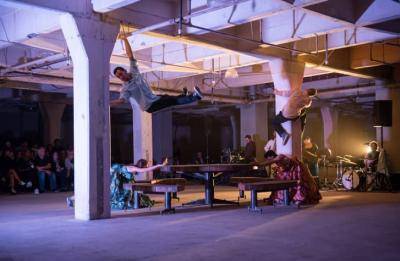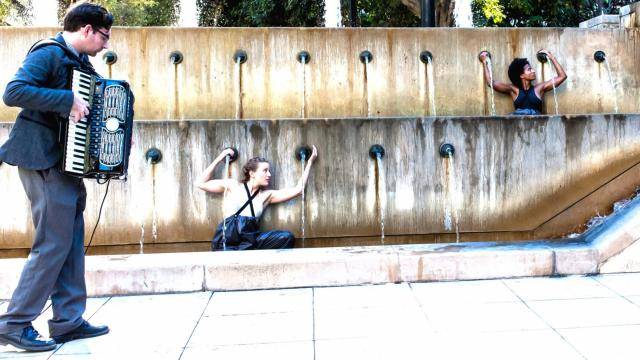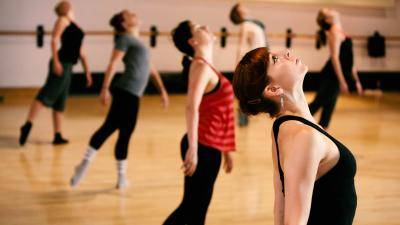As we move forward in this Corona-changed world, live performances for the arts will look different for the foreseeable future. One thing we can do is shift our craft out of the traditional proscenium or blackbox setting to adhere to social distancing guidelines. This pandemic forces us to find new places to share dance and satisfy our need to create. Looking back, modern and post-modern dance pioneers embraced this kind of evolution and today’s challenge pushes site-specific work as a possibility to keep performing in our given circumstances. By bringing our curiosity and experience to site-specific creation, we can continue sharing what we love in a new way.
Today, we have the post-modern movement to thank for opening our eyes to new possibilities for performance -- artists took to different locations to challenge the expectations of modern dance (and to avoid astronomical studio rental costs). There was a sense of exploration and practicality to the pieces, with the art challenging the ideas of “what is dance?”. Artists questioned the necessity of traditional venues of performance by dancing in churches, gymnasiums, outdoors, on walls, and experimented with avant-garde concepts. A few noteworthy, earlier pieces include Merce Cunningham’s “Museum Event No. 1” and Trisha Brown’s “Man Walking Down the Side of a Building”. These pioneers brought dance to new locations, seeking to prove that any place could be a home for dance. One notable, current company is Heidi Duckler Dance Company. They are based in LA, and specialize in site-specific performances, both for film and in-person audiences. The company has used hotels, underpasses, parking garages, laundromats, and most recently, Zoom. What is so exciting about site-specific work is that dance and movement can breathe life into any location or setting -- there are infinite places with potential to share dance with the world.

Here are some things to consider while creating your own site-specific piece:
The audience’s health and safety are the biggest considerations now. Not only is audience perspective important to the piece, but other precautions also need to be taken for social distancing to occur. The location needs to be large enough (or audience small enough) that there is a comfortable distance between everyone. For site-specific works, an in-person audience can behave unpredictably but still embodies the excitement of a live performance.
A live audience brings challenges and creative bonuses whether the choreography intends it or not. Audiences may do exactly what the choreographer hopes, like stay in a circle outside of the dancers, but all it takes is one person to wander into the circle or change their view and everyone else may wander as well. When you don’t want audience movement, an anchor like chairs, or anything immobile can offer a bit more control over the dancers’ surroundings. Similarly, it may be part of the choreography for the dancers to cue the viewers to move somewhere, but the audience members just don’t get it. A trick around this is to have a “plant” within the audience who knows where they need to go and can guide audience members to the right place. Or you could offer previews with selected audience groups to get feedback through test runs of your performance. Audience participation in close quarters may be tricky to control so contingency plans are a must.
Dance and movement can breathe life into any location or setting -- there are infinite places with potential to share dance with the world.
The foundational element of site-specific dances is the location itself. What is special about your chosen location and can be uniquely highlighted through the choreography? Locations can offer new factors, like more or less space, natural lighting, columns, fountains, trees, different surfaces, water, graffiti, buildings, ambient noise, and more. Seize opportunities to use space, sound, and speed, with uncommon elements, like splashing in water or sliding down railings, negative space or forced perspective. There can be interactive experiences between performers and audience members, think à la Sleep No More. Dancers can relate to each other on different levels employing stairs, or climbing a tree. They can use motifs for how the space around them moves. Heidi Duckler believes in choreographing and rehearsing in the location, so everyone in the process becomes familiar with the intricacies of the space. She creates plans for what she wants to relay through her pieces, while allowing room for inspiration that comes from being on location or how her dancers move together. In the end, Duckler sets everything in choreography but her dancers create their individual narratives, keeping the piece feeling fresh and natural.
If choreographing every detail sounds too rigid, another element that incorporates really well with site-specific movement is structured improvisation. Giving the dancers a score to work with can allow them to be inspired by the space they are in, as well as the choreography. Relationships in dance are formed between bodies and space, and when the space has additional features or something new to offer, more complex relationships can form.
Don’t be limited by the idea that site-specific works are rigid and can only be used in their original setting. While it is hard to imagine your work without steps, or columns, or whatever unique elements were originally incorporated choreographically, the creative problem-solving of moving locations can be part of the fun. Try your piece in its exact opposite setting: from fountain to field, hill to valley, playground to park avenue: to find what new relationships can be formed. Many site-specific artists set a piece in one location, and then take it on the road to cultivate the idea further. Some artists leave the choreography as is, and some adapt their choices according to what the new site demands. Lucinda Childs has toured pieces using both of these tactics. Her works that rely heavily on structure and timing, do not need to shift for space, they are kept as they are. However, she has allowed some pieces to be tweaked for new locations as long as they stay within her original score. “Street Dance” is one of Childs’s pieces, where the audience watches from windows high up in a building, as the dancers move to describe tiny architectural features. She re-staged it telling the dancers the original score, and allowed them the feeling of a new piece with the same roots. Through the touring and adapting of a piece, you can explore new artistic choices to incorporate the space’s “soul” or reveal that of the dance.
As the importance of contingency plans was mentioned earlier, it takes on extra gravity when pieces travel to new locations. This could be from changes in audience, weather, props, music, etc. These changes can alter how the dance reads in the space, or switch up dancer cues. It’s also necessary to consider having extra costumes or footwear, speakers/sound systems, or external factors like rescheduling due to weather. This list can extend depending on the location and how much of it is structured improvisation. It is incredibly helpful to work with dancers who are open to being flexible in the moment and act on their instincts to enable contingency plans.
By bringing our curiosity and experience to site-specific creation, we can continue sharing what we love in a new way.
One site-specific event I worked on was set around two ponds with a fountain, bridge, gazebo, and lots of space. There were four dances set in different sections of this location. I created my piece with the goals of playing with distance, perspective, and moving the audience. And, like those weren't enough elements to work with, I also incorporated a kite prop and live music. The dancers crossed the bridge, moved the audience, ran around the gazebo, and danced behind the fountain. As far as contingencies went, we had to plan for rain as well as people walking around and the handful of local animals... like geese. Not only are geese aggressive, but one of my dancers was terrified of birds. So, we had contingency plans for geese on either side of the ponds, people walking on the paths, the kite not working, and more. We reviewed and practiced these plans in our rehearsals. I included a couple “plants” in the audience spaced out so when it was time for them to move, some people knew where to go while the dancers guided the others. We didn’t have a lot of time to make and practice all these changes, so we spent a lot of time discussing them instead. I knew the dancers well and trusted their instincts. By performance time, whether we had discussed the plan or not, the dancers were ready for anything.
While theaters and studios may be closed for a while, that doesn't mean our work has to stop. Now, finding ways to continue sharing what we love means bringing our work to the audience in a less traditional way. We can explore unexpected choreographic avenues (literally) to continue making art that reflects on our current situation. As always, we will get creative within these new constraints, and stretch what we can do with dance.




